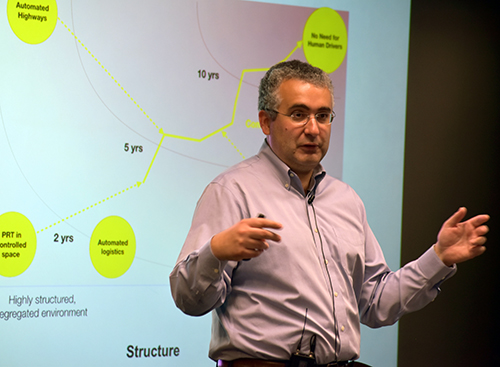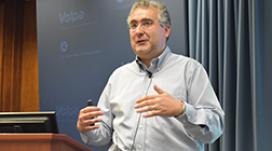Autonomy and Shared Mobility in the Urban Environment
Vehicle automation is paving the way for major societal changes in how we move people and goods in urban areas, according to Dr. Emilio Frazzoli, professor of aeronautics and astronautics at the Massachusetts Institute of Technology and co-founder of self-driving car company nuTonomy.
“I firmly believe that most of us own and drive vehicles that we do not really need,” said Frazzoli, the second speaker in Volpe’s Future of Transportation series. “I think the future is one that is based on a different model of mobility: shared mobility, shared vehicles. This is a future that presents a huge market opportunity.”
Massive Car Sharing, Massive Savings
Traffic crashes have an economic cost of about $300 billion and societal costs of about $600 billion per year in the U.S., Frazzoli said, citing data from the National Highway Traffic Safety Administration (NHTSA). Using his own estimation, Frazzoli equated the time that Americans spend stuck in traffic to about $1.2 trillion in lost wages.
Through nuTonomy, Frazzoli is aiming to design an urban taxi network that combines autonomous vehicle and ride-sharing technologies, and can cut into the societal and economic costs of private car ownership and operation.
“In a sense, the game-changing feature of autonomous cars is really their ability to drive themselves when there is nobody on board,” Frazzoli said. “This is really what is completely different from what we have today.”
In addition to economic and societal costs, there is lost value in land that is used for parking. Most cars are used only 5 percent of the time, Frazzoli said. Cars that drive themselves don’t need parking spots in prime locations, and can be used much more than 5 percent of the time. Frazzoli estimates the value of improved land use at $1.8 trillion from car sharing at a massive scale.
“We are actually paying dearly for the privilege of not using the asset that we paid for,” Frazzoli said. “Clearly this is not sustainable in the long-term at the global scale.”

Decoding the Levels of Automation
Vehicle automation is not an either-or choice, where a vehicle either has automation or does not. Automation has many flavors. NHTSA defines five levels of vehicle automation—from level 0 to level 4.
Level 0 automation represents no automation at all. A Ford Model T, for example, has Level 0 automation, Frazzoli said. At Level 1 there is mild automation, like anti-lock brakes and cruise control.
Level 2 combines two or more automation functions, and at Level 3 the car is largely in control but could still require a driver to take over.
“Any time you have a human in the [automation] loop in any kind of critical way, you’re looking for trouble,” Frazzoli said. “It saddens me as an aerospace engineer to see this happening.”
The aerospace community has known for decades that automation does not instantly make transportation systems safer, Frazzoli said. He emphasized that automation in aviation is augmented by highly trained operators: airline pilots. Compare this to driving, where operators may receive training once in their lives, often when they are teenagers.
Even with training, there is still a “chasm of human factors” at Levels 0 through 3, he said. Training can reduce errors caused by the human element, but humans can never be designed out of those levels. It’s not until level 4—full automation—that the societal and economic benefits of automation begin to take real shape.
“The way I see it, Level 4 is really what we need,” Frazzoli said. “It’s the only point where we can actually capture the benefits of this technology.”
Autonomous Vehicles in Singapore
Frazzoli’s company, nuTonomy, is poised to launch a trial fleet of autonomous, shared, ride-hailing vehicles in Singapore.
“I think that the time to having limited commercial deployments of this kind of technology is actually not that far away,” Frazzoli said. “Our company, we are looking at deployments by 2018. I don’t mean commercial deployment at scale, but limited commercial deployment where it makes sense and is safe.”
During his talk at Volpe, Frazzoli proposed a thought experiment based on computer modeling, where a fleet of 300,000 autonomous vehicles are deployed in Singapore as the only transportation option. This large-scale fleet would provide mobility to all residents, cut the number of total vehicles by 60 percent in the city-state, and free up 1.5 to 2 million parking spaces, Frazzoli said.
“There is enormous value for people who live in the city,” Frazzoli said. “You can transform these spaces and give them back, and not use them to store metal and rubber, but give them back to people.”

